The Finnish first division, Veikkausliiga, kicked off almost two months ago. At the time of writing, SJK remain the only undefeated side in the league, winning five and drawing two of their first seven top-flight games this term.
The club also have two games in hand over the two teams positioned above them on the table at present and if they win even just one of those two games, this will put them top of the table — a great feat for the Seinäjoki-based side who haven’t won the Veikkausliiga since 2015.
There are a lot of imposing aspects to their positive start to the season, not the least of which is the fact that they’ve got the youngest squad in Finland’s top flight this term, with an average age of just 23.4.
The team led by 36-year-old Joaquín Gómez — formerly an assistant at 2022/23 EPL stunners Brighton and Hove Albion and 2022/23 EFL Championship playoff finalists Luton Town — have produced stellar performances both in and out of possession to ensure this positive start to the campaign, as we’ll discuss in this tactical analysis piece providing an analysis of Gómez’s strategy and tactics in several different phases of play and scenarios.
SJK in possession
Our first section of analysis focuses on SJK in possession. Here, we’ll briefly examine how Gómez’s side build up their attacks, progress into the final third and typically finish their chances.
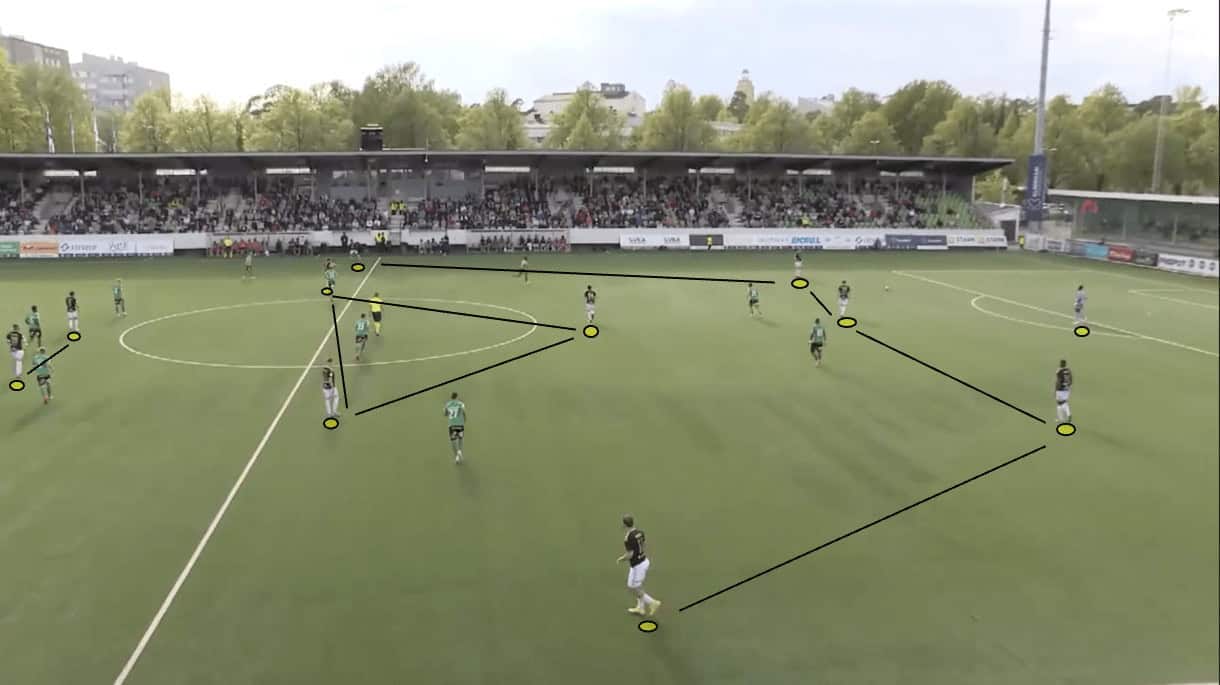
Firstly, SJK have primarily set up in a 3-5-2 shape this term — we see an example of how this shape typically looks during the build-up phase in Figure 1.
A holding midfielder is generally positioned centrally just in front of the central centre-back and behind two central midfielders who’ll be positioned slightly wider than the two centre-forwards ahead of them on either side.
One wing-back will normally be slightly higher than the other at this stage of the game due to how SJK approach the build-up from their goalkeeper. Two of the three centre-backs — the central centre-back and one of the two wide centre-backs — drop on either side of the goalkeeper on the edge of the six-yard box from the goal-kick. The wing-back on that wide centre-back’s side also drops but with the opposite wide centre-back having the license to sit a bit higher, so too does the wing-back on that side.
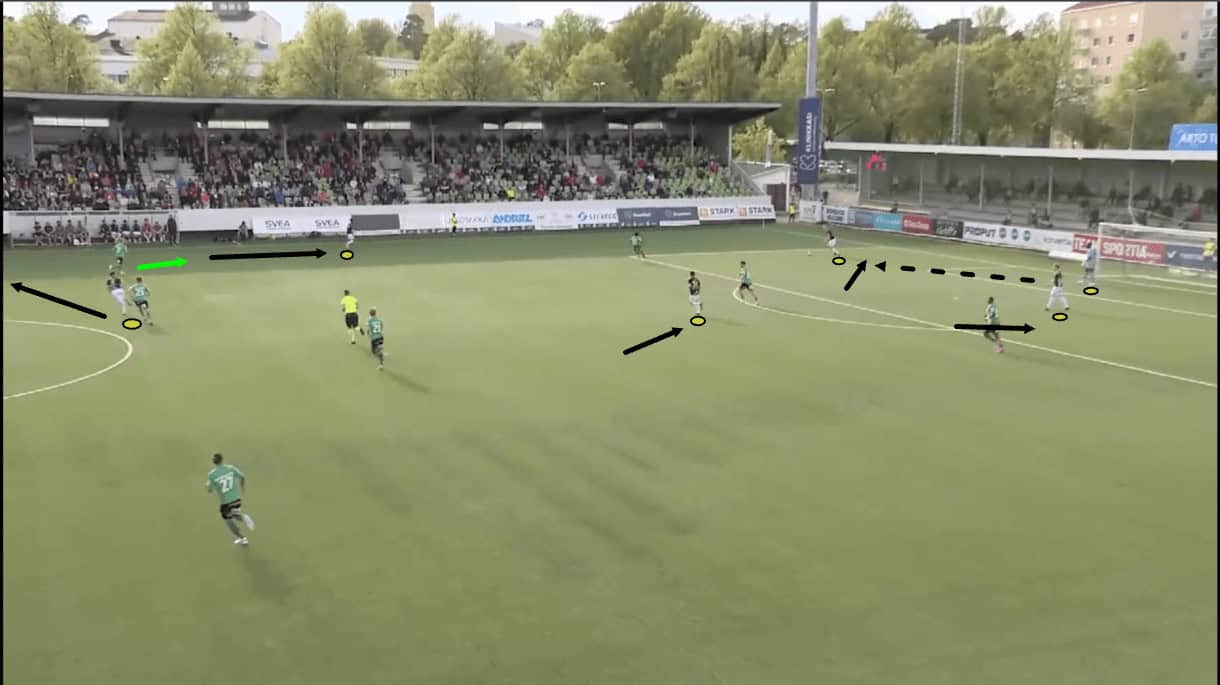
We see an example of SJK’s build-up in Figure 2 as well, with the right centre-back being the one who dropped deep on this occasion. As the right centre-back receives, the right wing-back, Kingsley Ofori, drops to provide an option but also to drag the opposition’s left-sided defender upfield, thus creating space for right central midfielder Jake Dunwoody to attack with an in-to-out run.
Gómez’s side doesn’t always do this on the right — it also occurs on the left — but it is a common sight to see the wide central midfielder rotating out into the wider channel in collaboration with some movement from the wing-back, especially the one who naturally drops deep in the build-up with the centre-back on that side.
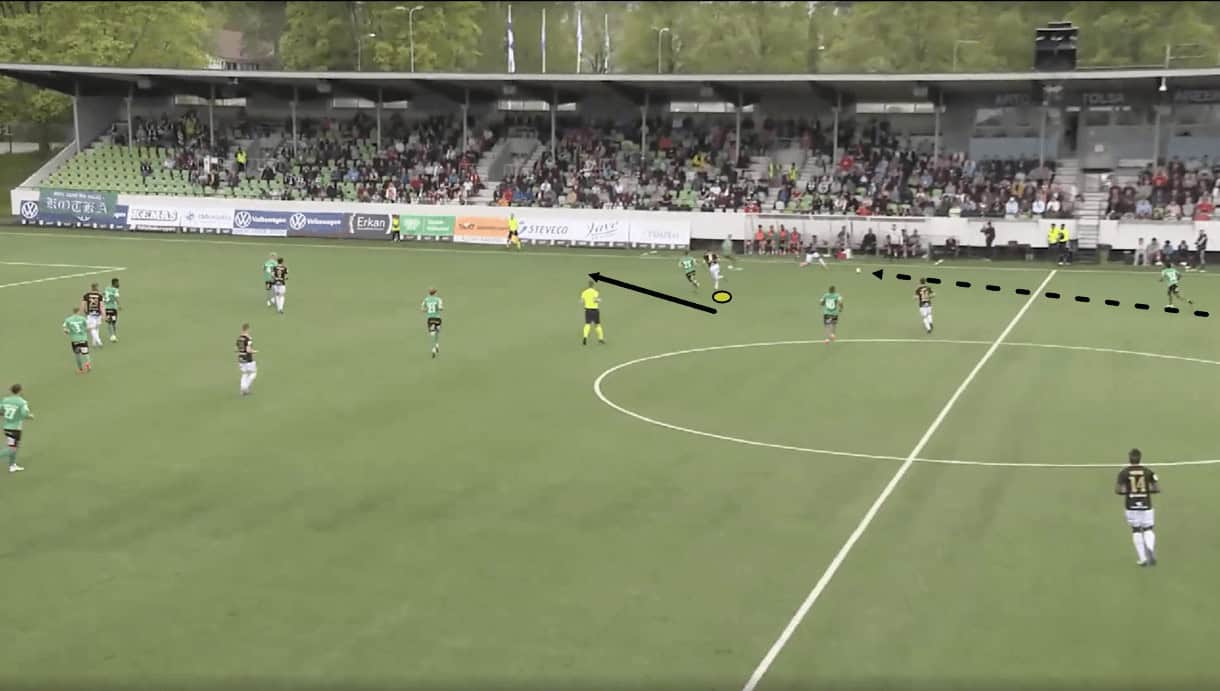
Another instance of this aspect of SJK’s game from this same fixture sees Dunwoody driving out onto the right wing behind the left-back who was dragged upfield by the wing-back once again — this time, as the wing-back drops to receive a pass to feet just inside the opposition’s half.
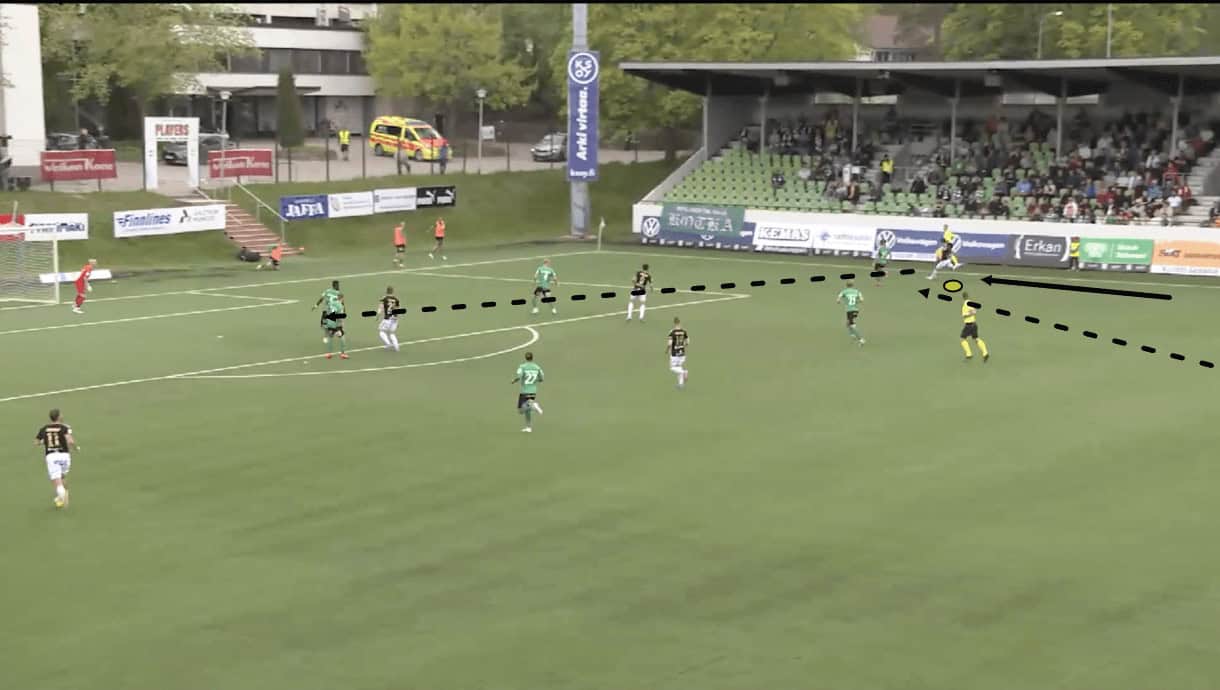
The wing-back manages to work the ball to Dunwoody and the central midfielder sends an inviting ball into the box for his centre-forwards to try and attack. This is a great segue into discussing SJK’s chance creation, as one major aspect of this for the in-form Finnish side is their wing play and crossing.
Dunwoody contributes to this a fair amount, as does Pyry Hannola who often starts on the left side of central midfield. However, SJK’s primary crossing threats are the wing-backs themselves, despite the above tactic of those players dropping off to drag the opposition’s wide defender away and create space for the central midfielder out wide; right wing-back Ofori has made 3.76 crosses per 90 this term while left wing-back Murilo has made 4.68 crosses per 90 — the most of any SJK player.
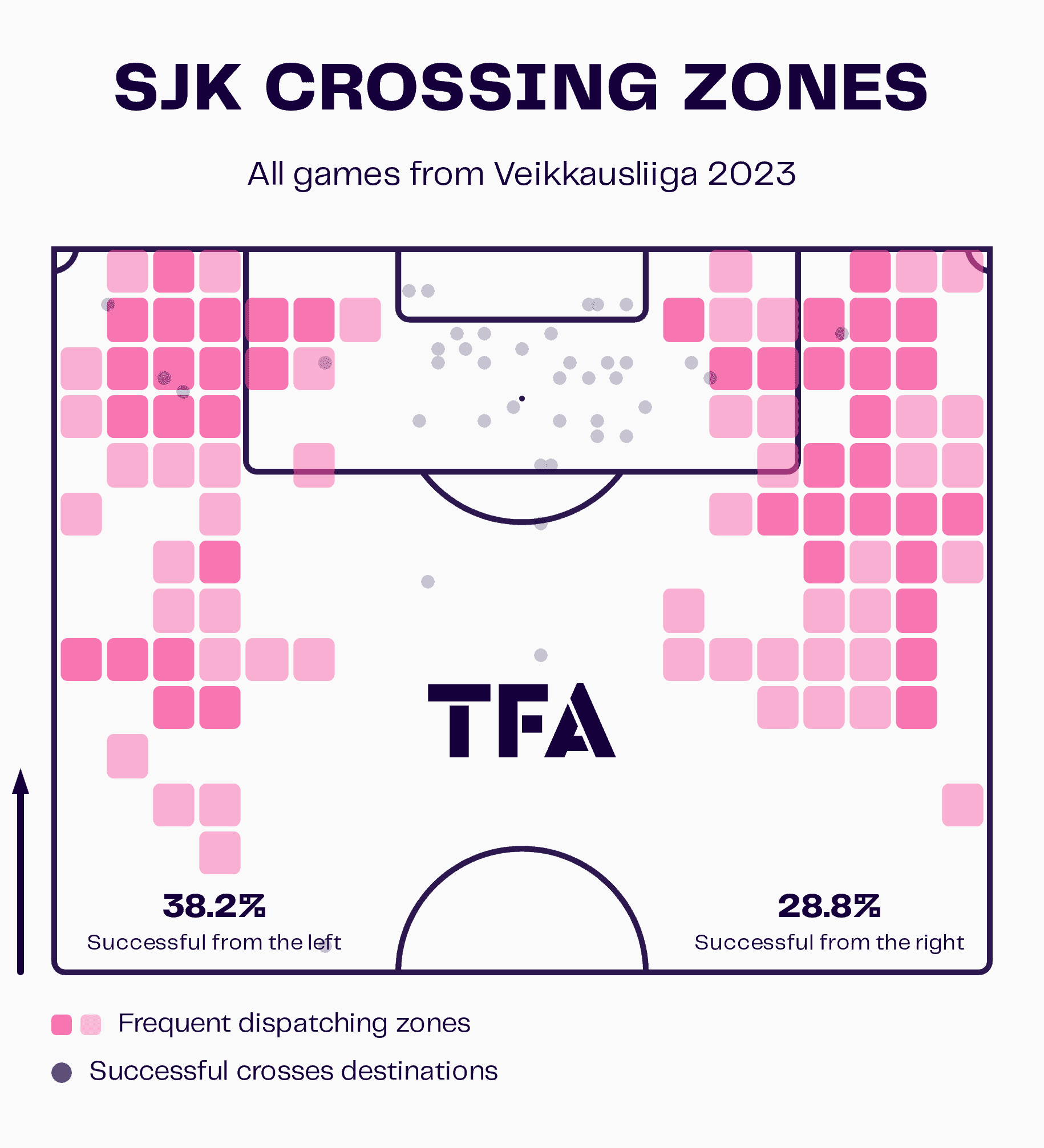
As Figure 5 displays, SJK’s crossing zones vary quite significantly — sometimes, they’ll cross early from deep while on other occasions, they’ll work the ball towards the box a bit longer and cross from closer to goal.
They’ve enjoyed greater crossing success from the left than the right this term, largely a testament to left wing-back Murilo’s quality as while he’s played the most crosses of any SJK player, he’s also retained a stellar 42.86% cross success rate. Ofori on the right has also been quite impressive with his crossing — managing a 37.5% cross success rate.
SJK typically float crosses into the box rather than drilling them low and hard, looking to take advantage of the height on offer from 188cm/6’2” Jeremiah Streng and 183cm/6’0” Jaime Moreno along with the late runs into the box from 180cm/5’11” Jake Dunwoody who’ll sometimes meet Murilo’s crosses at the back post and 184cm/6’0” Pyry Hannola who’ll occasionally be there to attack Ofori’s crosses.
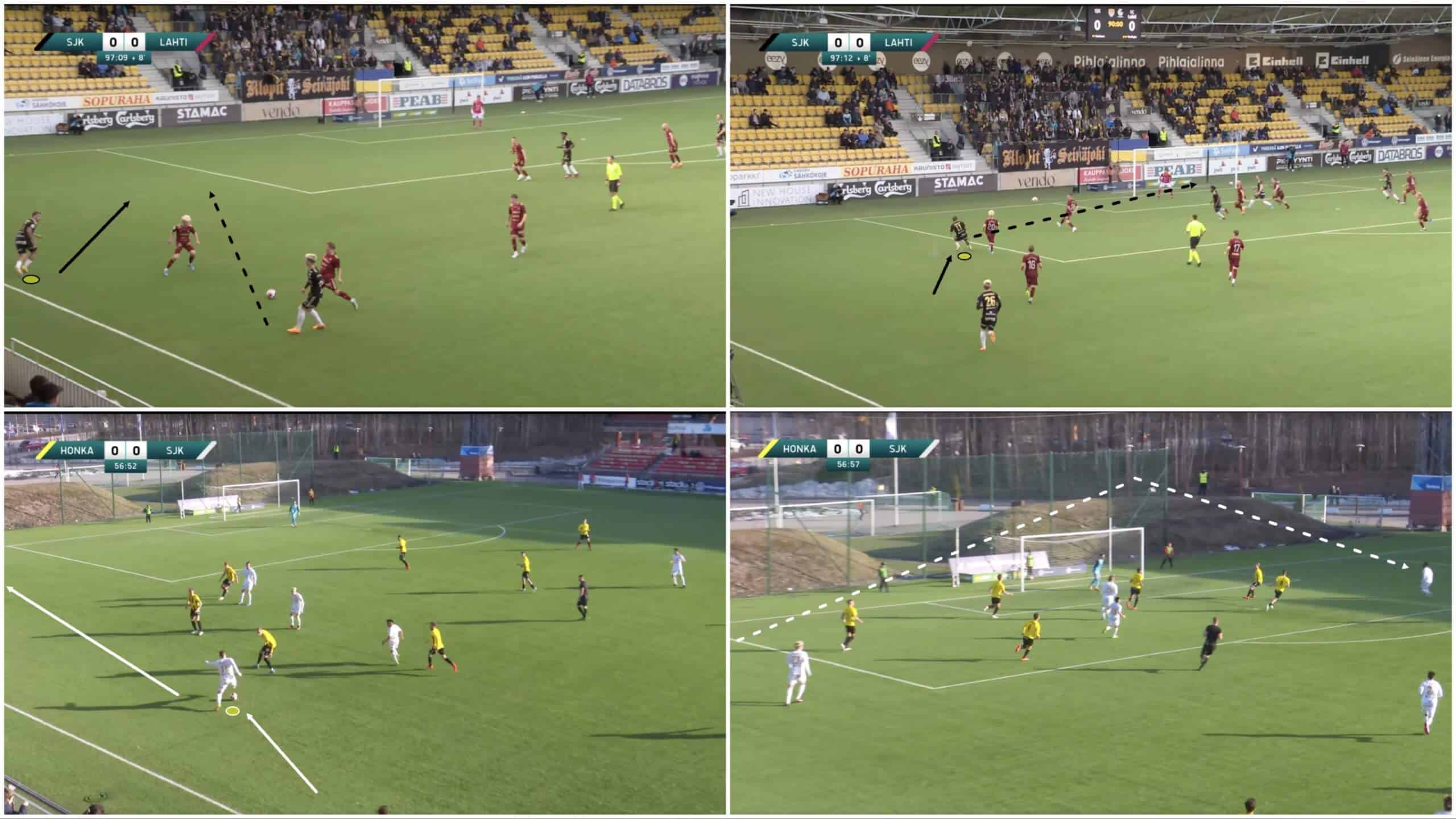
Murilo is a key player for his side that all opponents need to prepare a game plan for. As Figure 6 shows, he can threaten significantly via backline-breaking runs in behind to get into a good crossing position while he’s also capable of driving into said positions himself thanks to his impressive dribbling ability; Murilo’s also one of the best ball carriers in this team.
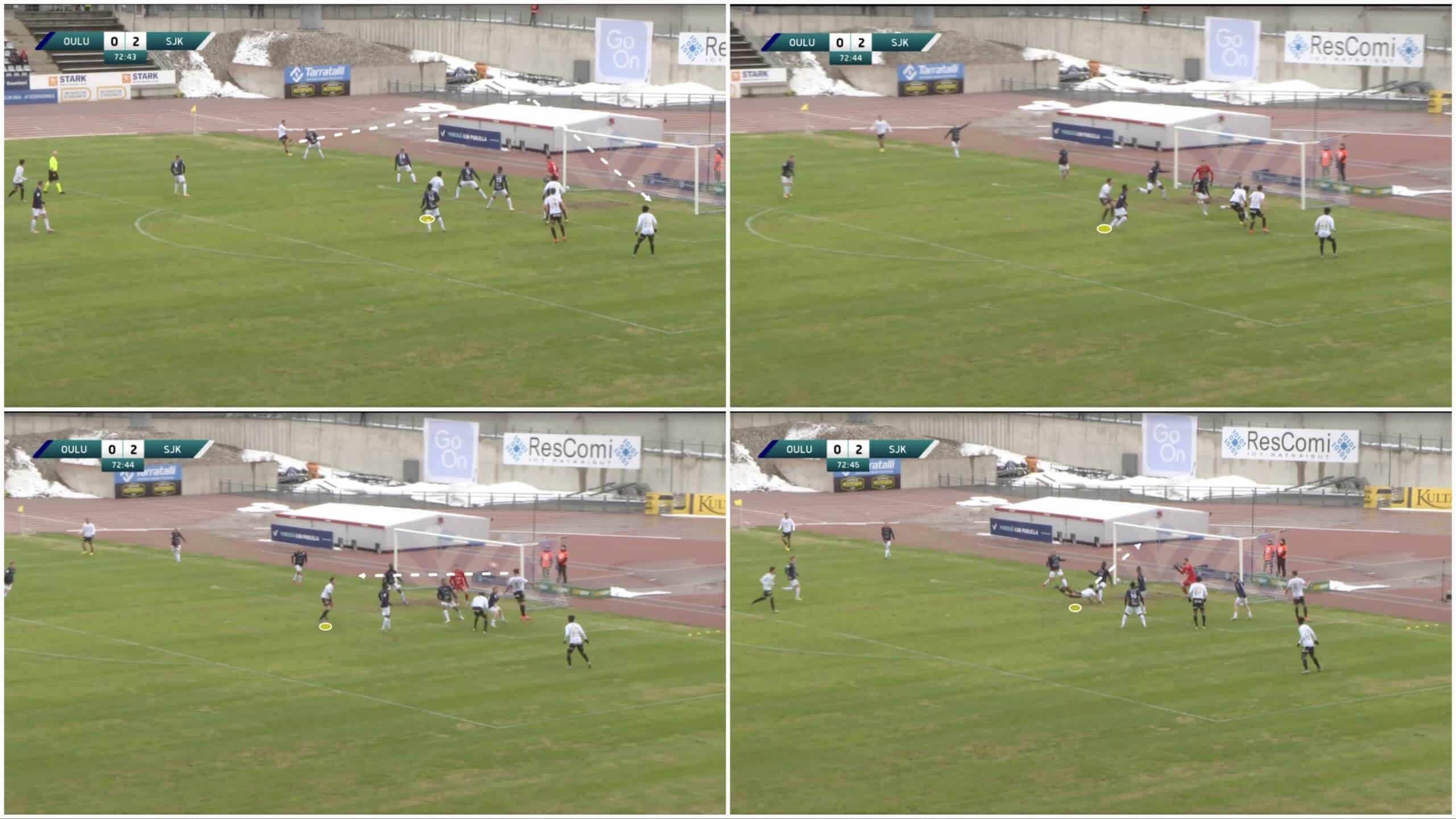
Jaime Moreno is currently SJK’s top goalscorer in the league this season with five to his name. His off-the-ball movement inside the danger zone has been a key reason for his goalscoring run — especially used in combination with the elite delivery he’s receiving from the wings.
Here in Figure 7, for instance, we see Murilo floating a ball in to the far post where Dunwoody meets it at the edge of the six-yard box — sending it back across goal and into the centre of the box where Moreno’s positioned to attack the ball and send it into the net.
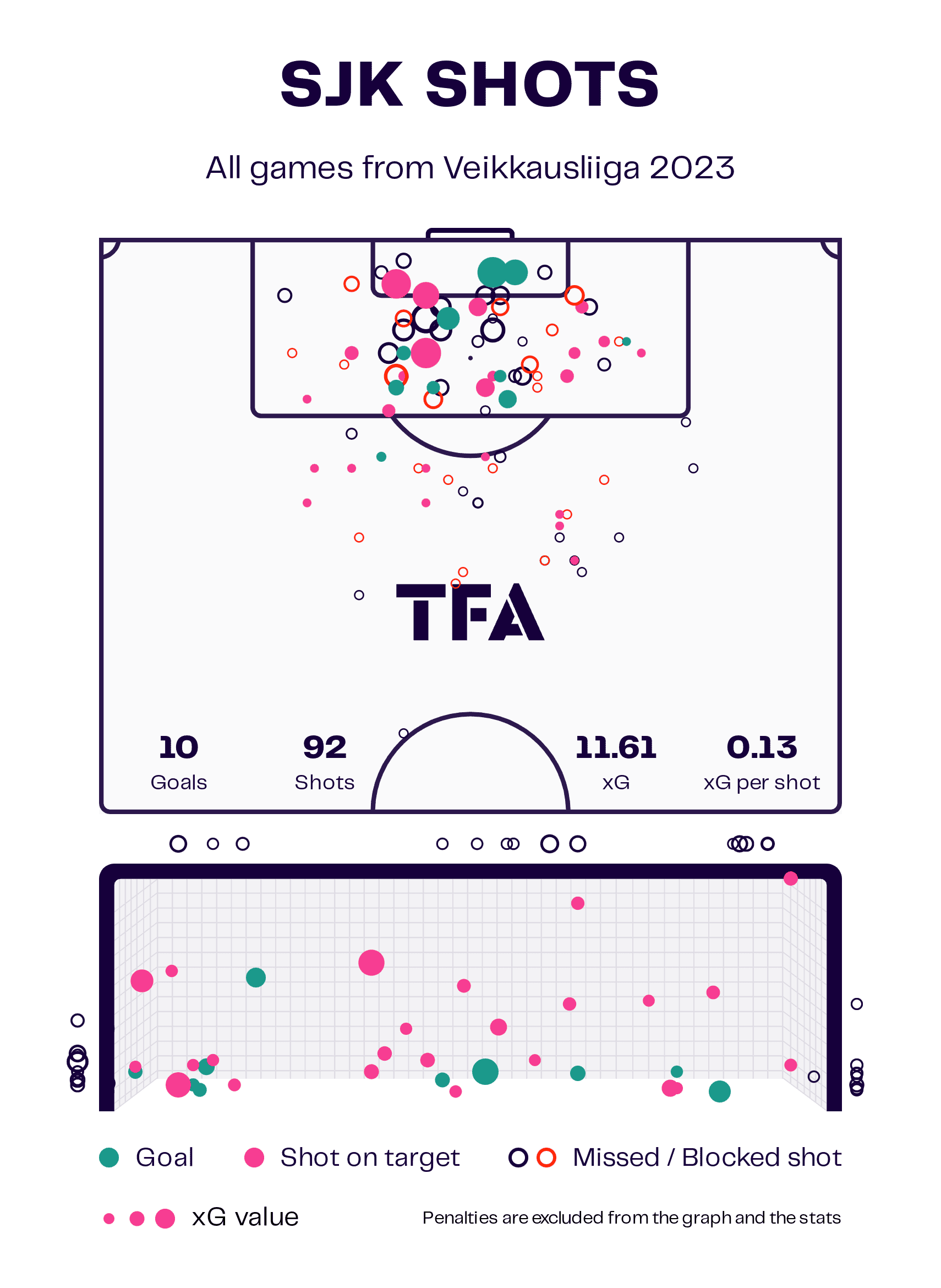
As we see from his 2023 shot map, Moreno is very efficient with his shots, typically making attempts from very high-value areas and being rewarded with a goal just over every four shots in the league this term — a very nice return. He tends to stay around the penalty spot or edge of the six-yard box, rarely leaving the width of that area.
This, in combination with subtle movements to lose his marker as displayed in Figure 8 above, helps him avail of great opportunities on a regular basis. Overall, SJK have scored the fourth-most goals (10) in Finland’s top-flight this term but they have the third-best xG (11.61) — a result of their systematic chance creation but also the individual quality from the forwards and creators.
Transitions
Another key reason for SJK’s goalscoring prowess this term has been their quality on the counterattack. Both centre-forwards, Moreno and Streng, also provide a decent level of pace that can exploit space in behind the opposition’s backline in transition.
This has seen the passing quality of players such as right centre-back Matej Hrádecký and left centre-back Terry Yegbe come in clutch at times as they can quickly spring counterattacks over the top with good enough passing ability for the centre-forwards to take advantage of the situation and progress into a decent shooting position.
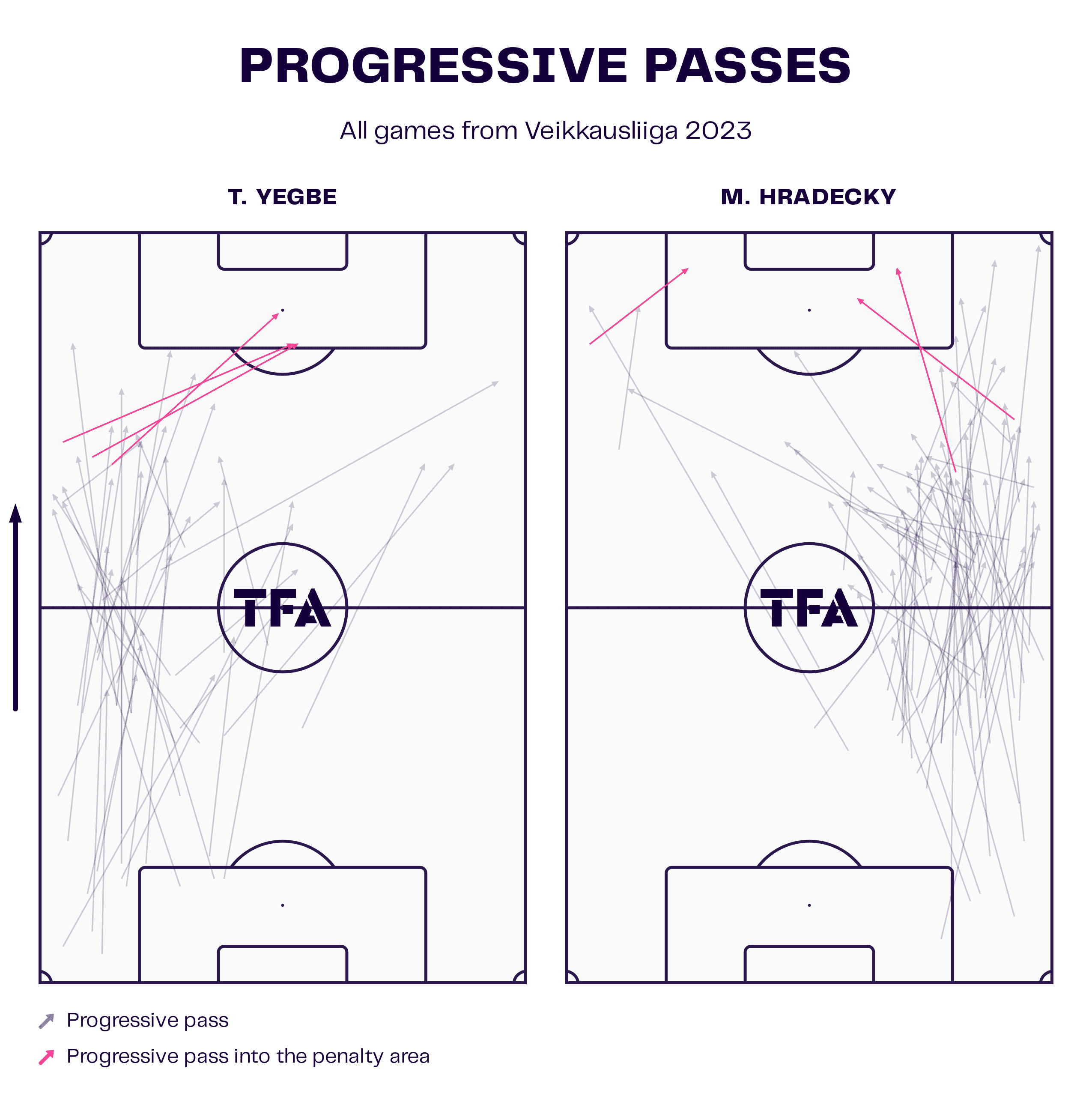
Figure 9 displays the progressive pass maps of the two aforementioned centre-backs from 2023. Both Yegbe and Hrádecký are very comfortable players on the ball with the ability to contribute in the build-up and progression phase as well, but they’ve shone for SJK in transition this term.
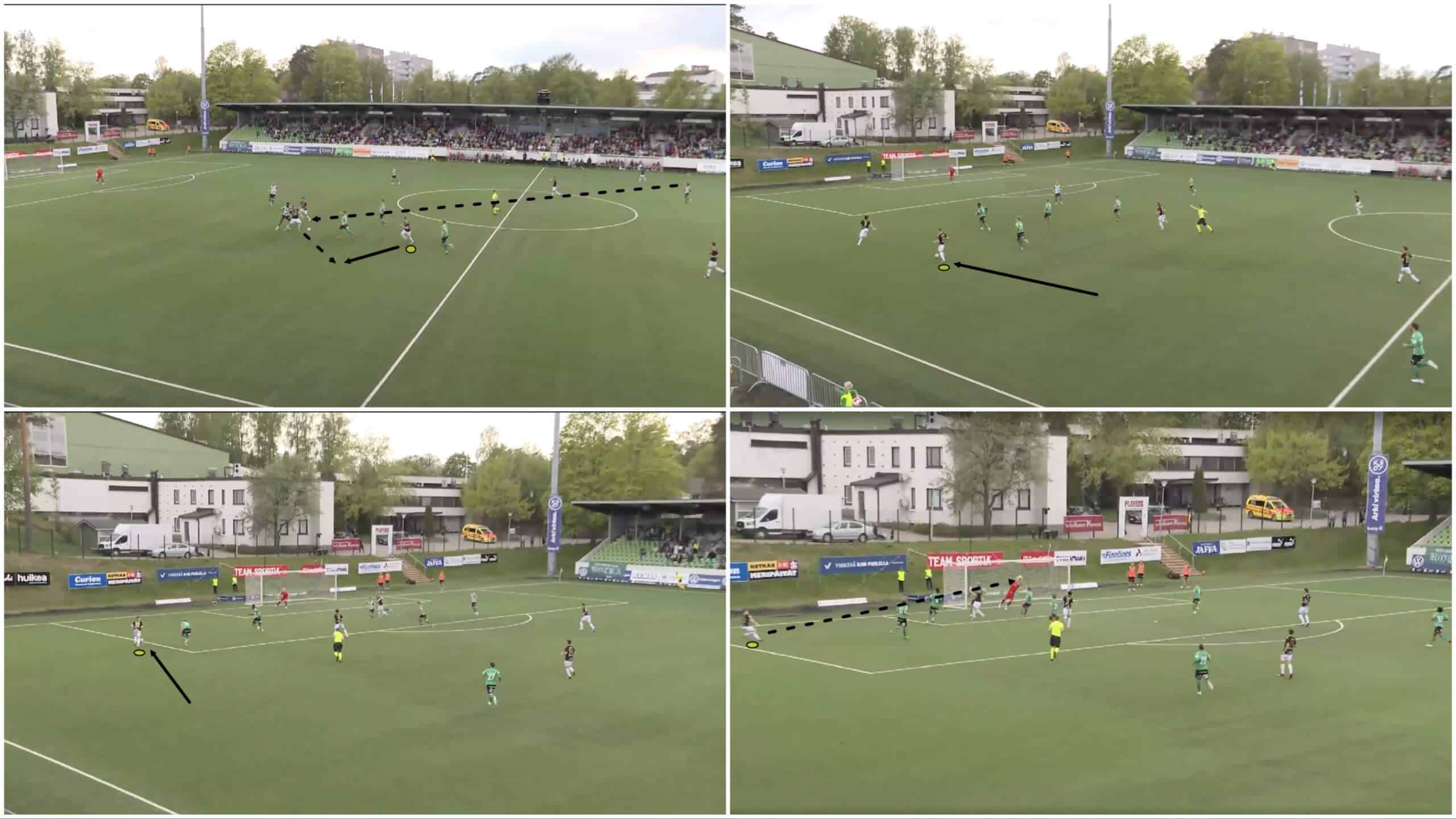
It’s not just balls into space over the top that the centre-backs offer, their long passing accuracy can also help SJK find a target man up top in transition, and that player can then link up with a nearby teammate to put the opposition on the back foot as was the case here when the ball was played upfield for Streng to take it down and play it off to left central midfielder Tuomas Kaukua.
From here, the wide central midfielder acts as we know is common for SJK’s wide midfielders — taking the ball high and wide, into a decent crossing position from where he can threaten the opponents’ goal.
All this came from a Yegbe long ball directly from SJK’s own box, highlighting how crucial the centre-backs’ long passing can be in quickly creating decent attacks for the Seinäjoki club.

The wing-backs also play an important role in this part of SJK’s game, acting as key ball carriers when SJK regain possession and quickly pass out into the wide area. Murilo, in particular, has stood out as an essential asset in this regard in 2023.
Figure 11 is SJK’s ball progression map from 2023, highlighting their dribbles and progressive runs from the campaign. Plenty of these come in transition as SJK look to run at the opposition and quickly put them on the back foot.
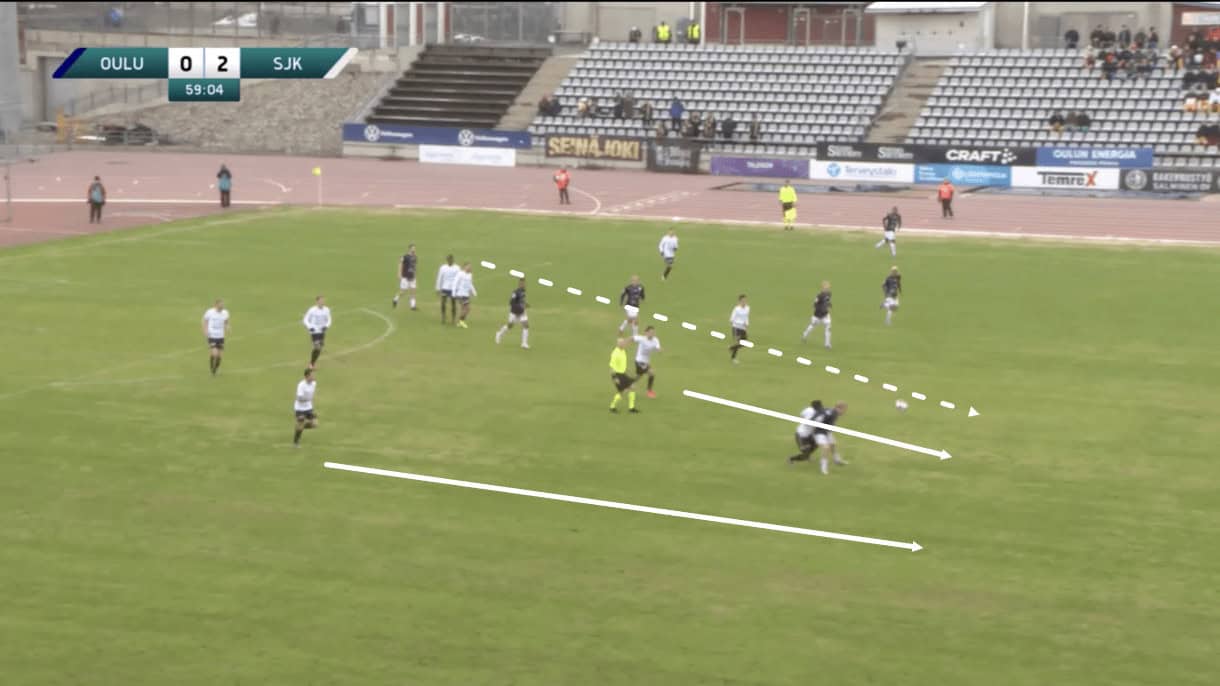
Figures 12-13 highlight another in-game example of SJK creating via the counterattack. Just before this image, the opposition were in possession, threatening the Finnish side’s goal. The ball was subsequently cleared away by the SJK centre-back, towards a teammate threatening to receive and carry into the opposition’s half on the counter.
The nearest opponent reacted by turning his back to goal and trying to use his body to shield the ball from said attacker but this acted as a trigger for SJK’s other two nearest players to pounce and overwhelm the opposition player trying with all his might to defend the ball and brace his team for the impending transition.
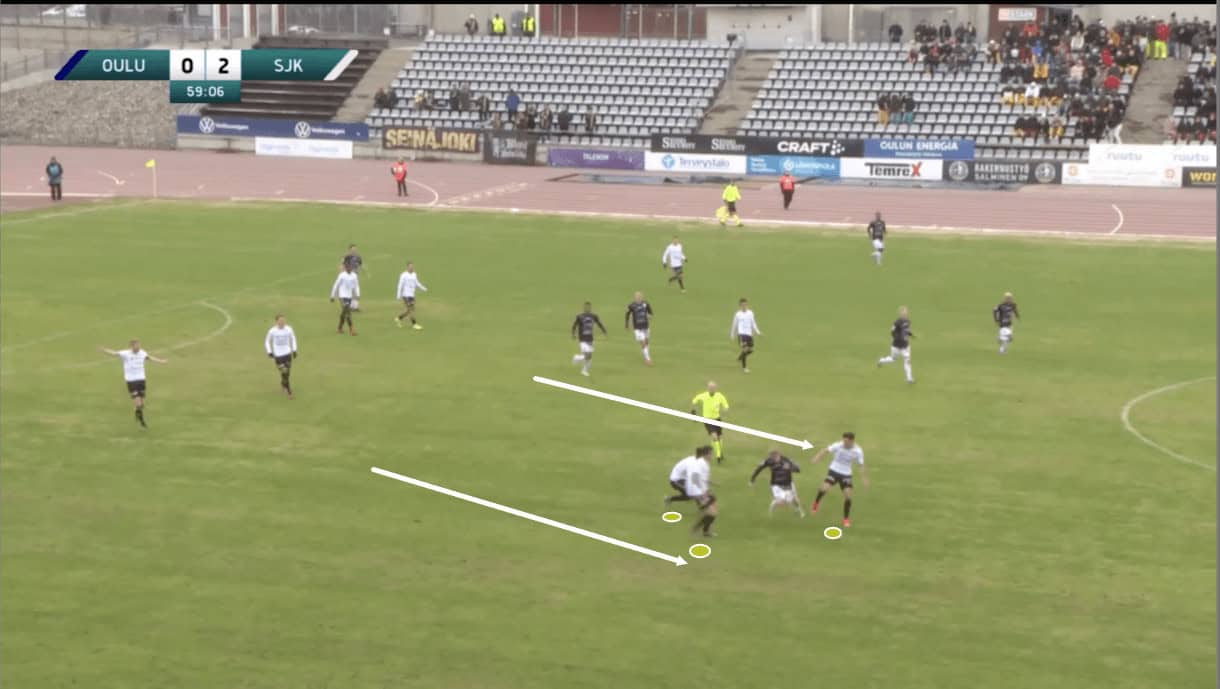
It ends up being 3v1 by the time any of the other opposition players look like helping out and providing support, but it’s too late by that point as SJK have regained possession and are in a great position to charge towards the opposition’s goal, which they go on to do by playing a through pass to the forward ahead who can continue the attack in behind the backline.
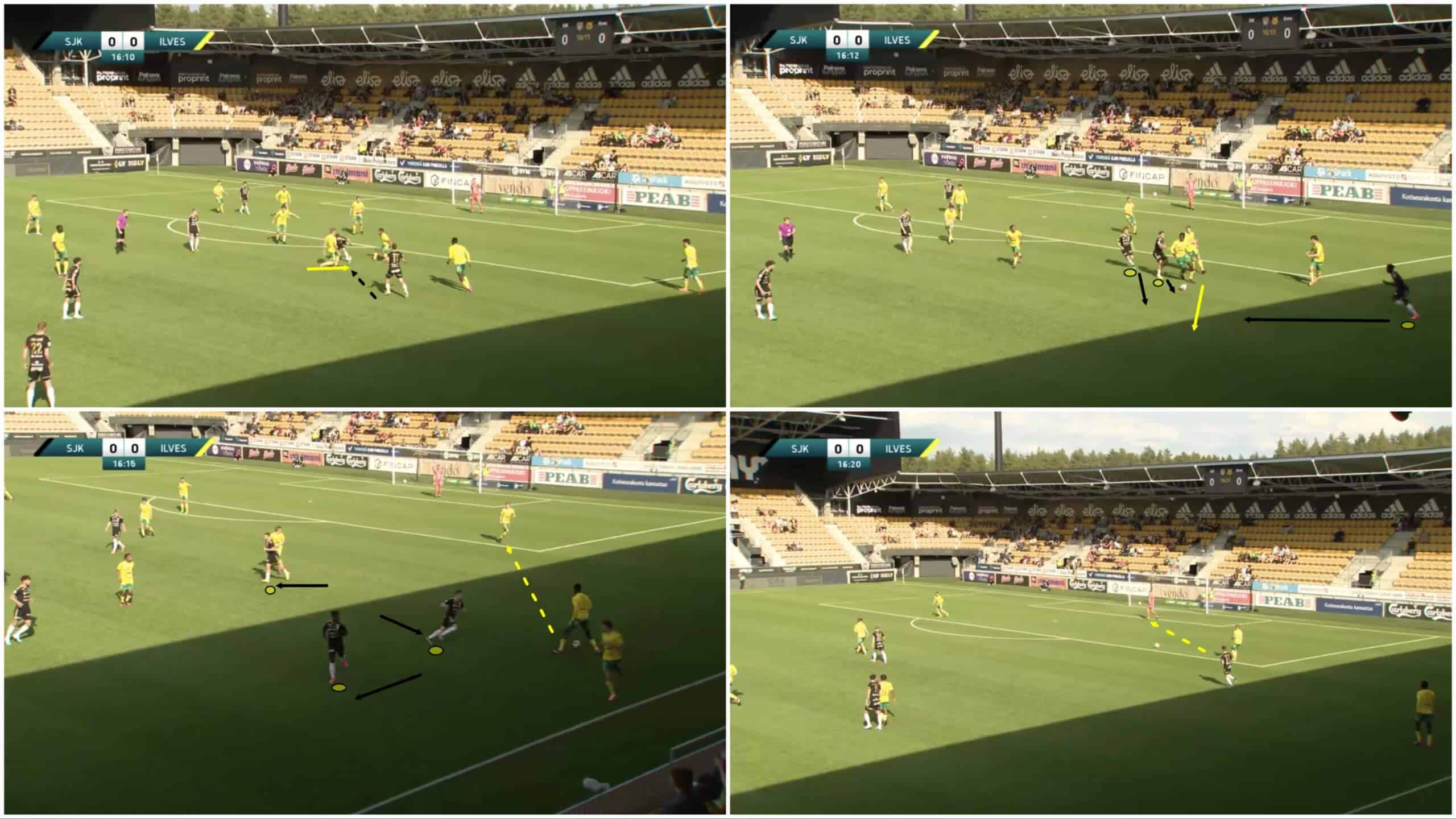
As for transition to defence, SJK are equally well-prepared in this department and typically swarm around a ball carrier in a similar manner to what we saw in the previous example when counterpressing.
Take Figure 14, for example — here, SJK have just lost possession on the edge of the opponent’s penalty area. However, they react well with one player, the right wing-back, coming across to immediately slow down the opposition ball carrier while other nearby SJK bodies cover off the ball carrier’s best passing options.
This ultimately leaves them with a few options — they can play the ball long, which is risky in this scenario; they can continue carrying it upfield themselves and see how far they make it, also risky; or they can focus on retaining possession by going backwards. The latter is the option they went for here but this slows down the attack, effectively kills the counterattacking threat and gives SJK time to reorganise, making their job of breaking them down a lot more difficult.
SJK have been very good at shutting down counterattacks this term; the young team always come with lots of energy and Gómez has them very well prepared for what to do and what dangers to look out for just after losing possession. As a result, they’ve kept their opponents’ counterattacking threat to a minimum.
Out of possession
Lastly, our final section of the analysis focuses on SJK out of possession. We’ve arguably saved the best until last here, as out of possession may be the area in which SJK have shone the most in 2023, conceding just two goals so far — the fewest in Veikkausliiga — while conceding an xG of just 4.42 — also the lowest in Finland’s top-flight.
Their xGA per shot has been 0.077, which is a fair amount lower than second-last in this regard. So, where Jaime Moreno thrives in getting high-quality goalscoring chances on the regular for SJK, the team are equally excellent at preventing the opposition from enjoying such opportunities.
In accordance with their love of attacking transitions, SJK try to create lots of them by pressing very aggressively. Their PPDA (7.96) is the lowest in Veikkausliiga for 2023 — an indication of their high-pressing intensity.
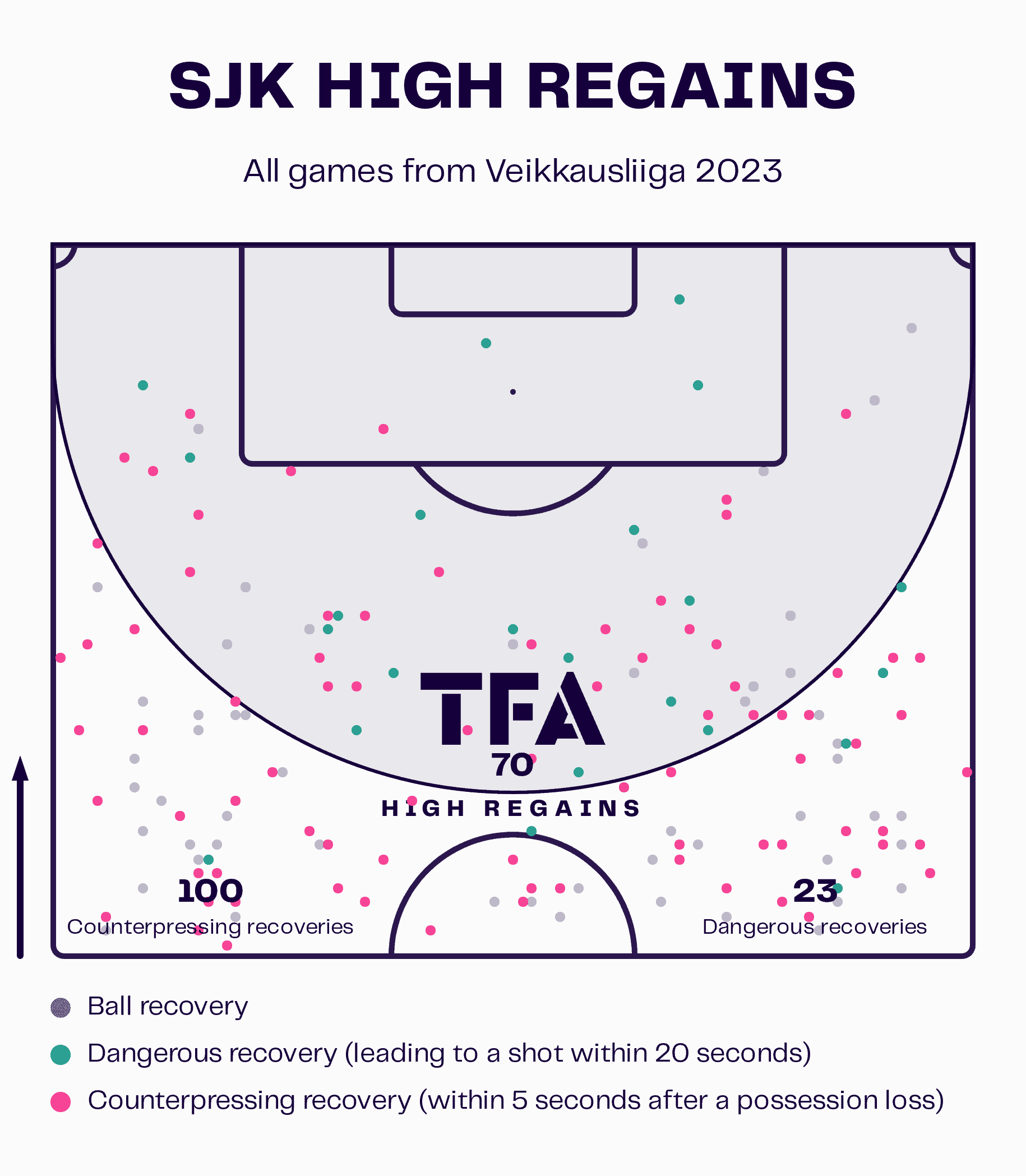
Figure 15 highlights SJK’s high regains from this season. They’ve made 70 high regains, 100 counterpressing recoveries and 23 dangerous recoveries (all defined by the legend on the visual) in just seven league games.
This is a testament to the work ethic and energy they bring to the pitch every game, as well as the level of defensive organisation Gómez has managed to formulate here, as their opponents are finding it very difficult to get through their sturdy defensive shape.
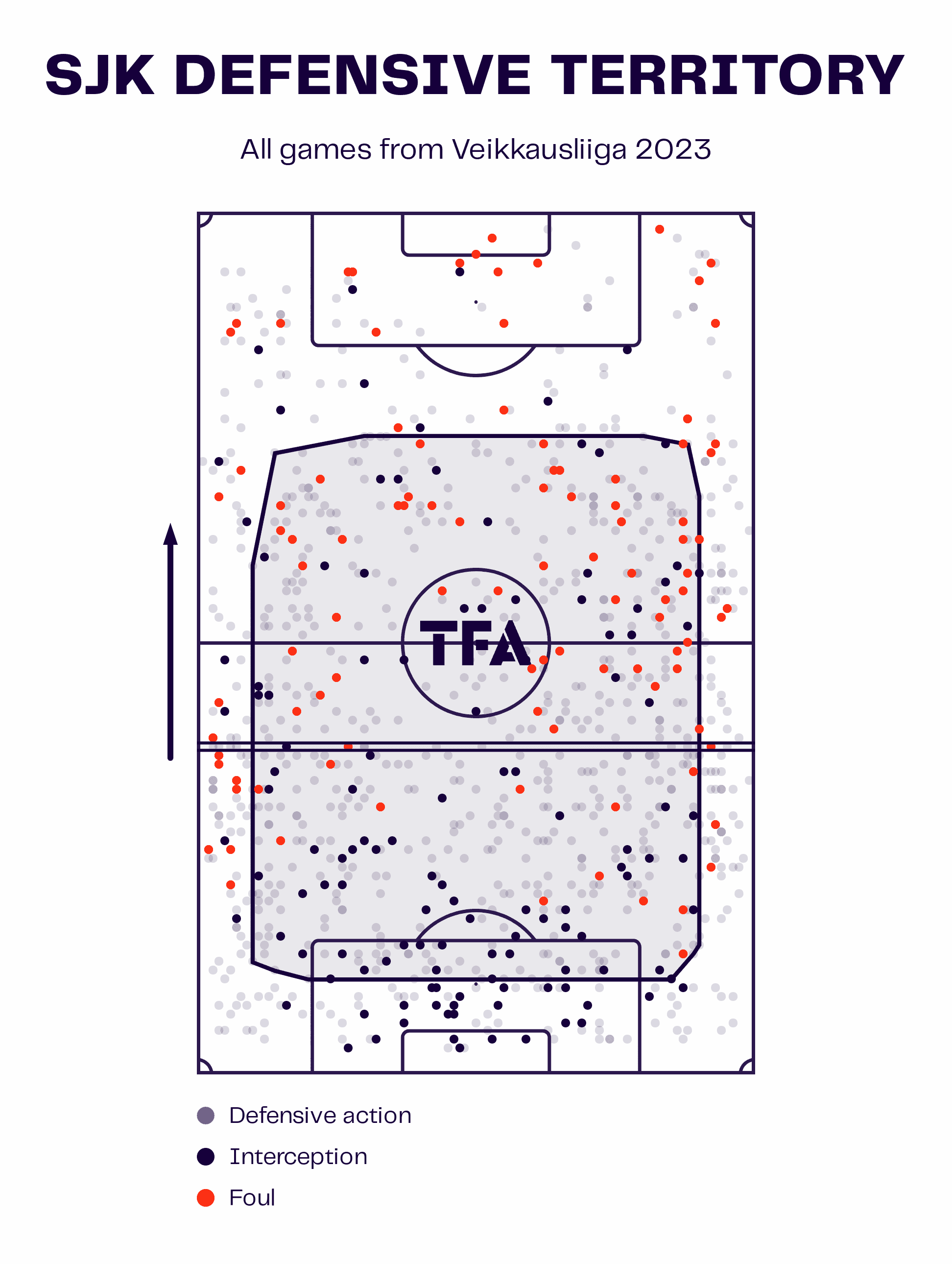
SJK play with quite a high defensive line, on average, sitting not too distant from the halfway line. We can see this along with their average defensive territory in Figure 16 above.
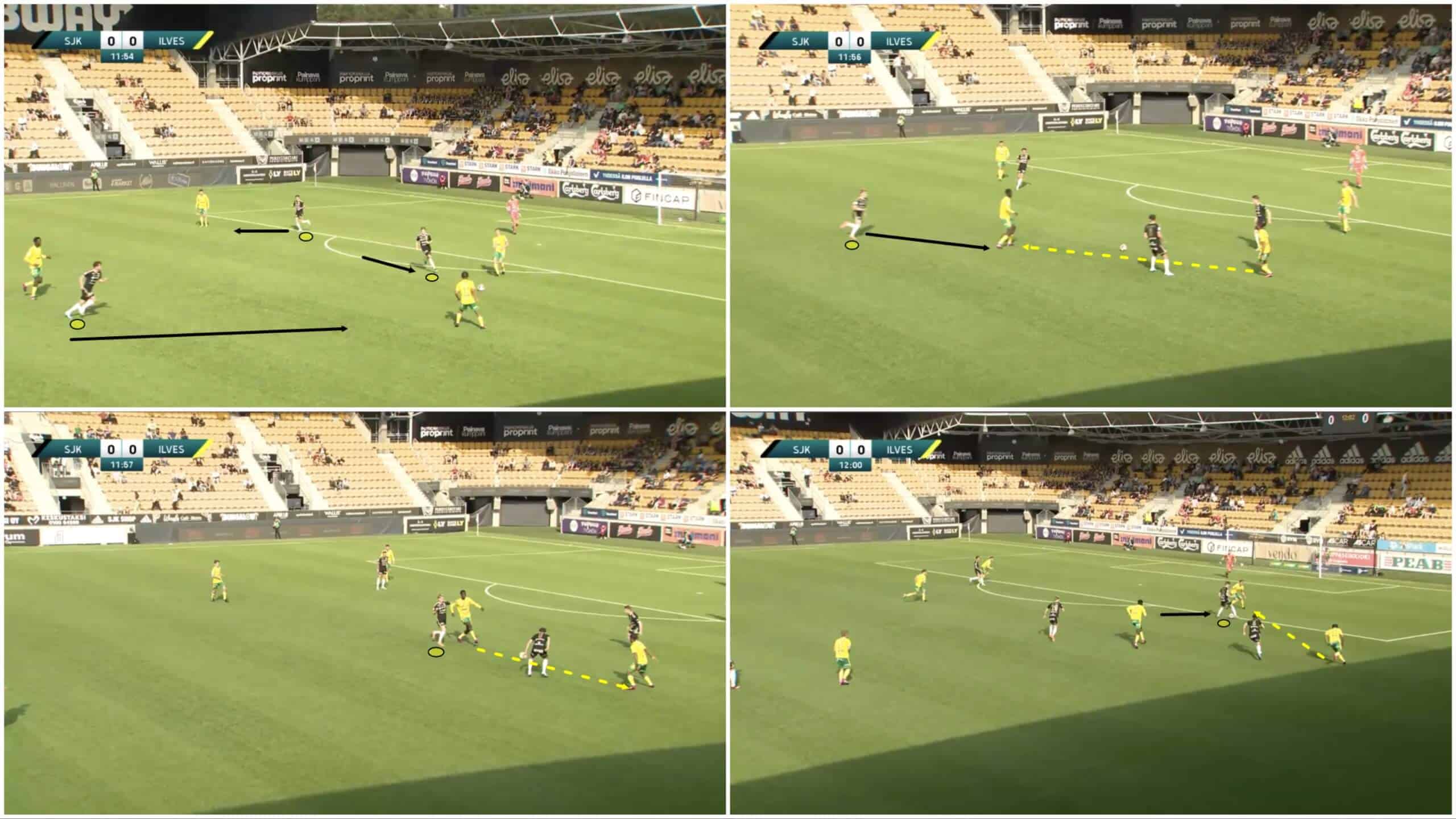
Figure 17 highlights SJK’s press in a particular instance from their recent league game versus Ilves. We see how they start the press high, just on the edge of the opposition’s box, as the opponent begins to build out from the back.
The centre-forward duo lead the press, with the ball-far forward cutting off the pass across goal to the other centre-back and the ball-near forward closing the ball-carrying centre-back down while also keeping the passing option across goal in his cover shadow.
SJK’s right and left central midfielders get very close together, almost as if they were the second ‘2’ in the 4-2-2-2 shape. This is typical of their performance in Gómez’s side out of possession; while they tend to move from in to out frequently in possession, they are often quite narrow out of possession, ensuring control of the centre and that they’ve got plenty of bodies near one another to swarm an opposition player at the appropriate moment when triggered to increase their pressing intensity.
The aggressive pressing forces the opposition’s left central midfielder into a quick pass when he receives the ball, leading to the right central midfielder receiving with his back to goal. This draws the left central midfielder’s press in from behind as he looks to halt the receiver in his tracks, preventing him from turning and buying time for his central midfield partner and/or a forward to come back in support to charge this new ball carrier down too.
The player does well not to lose possession immediately, buying his team some time by playing it back to the left central midfielder but SJK keep the pressure high with so many bodies positioned so close to one another here, and as the left central midfielder tries to go back as well, they get caught out as SJK’s forward reads the incoming pass well and intercepts on the edge of the box, creating a great opportunity for the Seinäjoki team to attack the box.
This is one of many examples of SJK’s press being very effective this season, denying the opposition progression with their intense press and forcing mistakes by continuing the relentless approach.
Conclusion
In conclusion, SJK have an intense approach to the game that’s been quite fun to watch in Finland’s top division in 2023. They love to attack via the wings and in transition, while they defend with a lot of aggression and intensity. If they can avoid major injuries, this approach looks like it could deliver a first title since 2015 to the Seinäjoki club but only time will tell. At present, the numbers on the face of things and underlying numbers all read very nicely for Veikkausliiga’s youngest team.





Comments